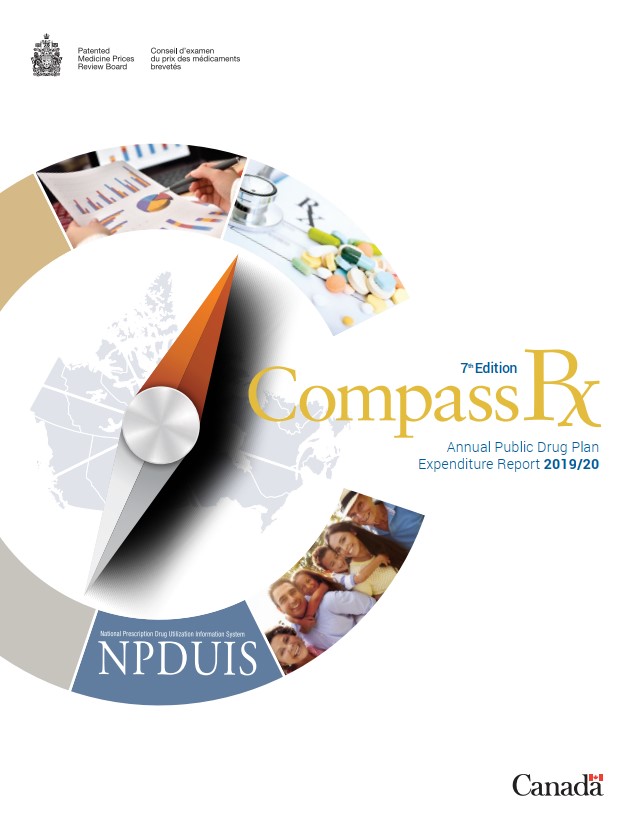CompassRx, 7th Edition
Executive Summary
Prescription drug expenditures for the NPDUIS public drug plans rose to $12.5 billion in 2019/20, an increase of 3.7% over spending in 2018/19. While new restrictions on eligibility requirements in Ontario’s OHIP+ program had a significant impact on costs, the overall growth in prescription drug expenditures continued to be primarily driven by notable increases in the use of higher-cost drugs.
The PMPRB’s CompassRx report monitors and analyzes the cost pressures driving changes in prescription drug expenditures in Canadian public drug plans. This seventh edition of CompassRx provides insight into the factors driving growth in drug and dispensing costs in 2019/20, as well as a retrospective review of recent trends in public drug plan costs and utilization.
The main data source for this report is the National Prescription Drug Utilization Information System (NPDUIS) Database at the Canadian Institute for Health Information (CIHI), which includes data for the following jurisdictions: British Columbia, Alberta, Saskatchewan, Manitoba, Ontario, New Brunswick, Nova Scotia, Prince Edward Island, Newfoundland and Labrador, Yukon, and the Non-Insured Health Benefits Program.
The findings from this report will inform policy discussions and aid decision makers in anticipating and responding to evolving cost pressures.
Key findings
Prescription drug expenditures for the NPDUIS public drug plans increased by 3.7% in 2019/20, bringing annual spending to $12.5 billion.
- Between 2014/15 and 2019/20, the total prescription drug expenditures for Canada’s public drug plans rose by $3.1 billion, for a compound annual growth rate of 5.5%.
- Drug costs, which represent 80% of prescription drug expenditures, grew by 4.3% from 2018/19 to 2019/20, while dispensing costs, which account for the remaining 20% of expenditures, grew by 1.4%.
- The NPDUIS public drug plans paid an average of 87% of the total prescription costs for 300 million prescriptions dispensed to almost 7 million active beneficiaries in 2019/20.
- Changes to the OHIP+ program accounted for a 4.8% decrease in total prescription drug expenditures for Ontario in 2019/20 and a 2.9% pull on spending for all NPDUIS public drug plans.
Drug cost growth for the NPDUIS public plans in 2019/20 was primarily driven by a greater use of higher-cost drugs and was offset in part by the decreasing use of DAAs for hepatitis C and plan design changes in Ontario.
- The increased use of higher-cost drugs continued to be the most pronounced driver in 2019/20, pushing costs upward by 5.8%, while declining use of direct-acting antivirals (DAAs) for hepatitis C had a pull effect of -1.6%.
- Nearly 60% of the total drug costs in 2019/20 were attributable to just 5% of public drug plan beneficiaries. High-cost drugs, which were used by 2% of beneficiaries, accounted for more than one third of costs.
- The overall increase in costs was tempered by changes in eligibility for Ontario’s program for those age 24 and younger. Without OHIP+, the 4.3% total drug cost growth in all NPDUIS public drug plans would have been 7.8%.
- Changes in the size of beneficiary populations pushed costs up by 3.0% in 2019/20, due in large part to the expansion of British Columbia’s income-based plan.
- Following a substantial 6.2% pull on costs from generic pricing initiatives in 2018/19, price reductions and generic and biosimilar substitution had a very slight -1.2% effect in 2019/20.
Dispensing costs in the NPDUIS public plans increased slightly to $2.5 billion in 2019/20 due to opposing forces from plan design changes in British Columbia and Ontario.
- The overall growth in dispensing costs was 1.4% (or $35.4 million) in 2019/20, a more modest increase than the 5.1% growth observed in 2018/19, though results varied among individual plans.
- Modifications to the OHIP+ program had a significant impact on the growth in dispensing costs, pulling costs down by 2.3% ($56.3 million) nationally and by 4.1% in Ontario.
- An increase in the number of active beneficiaries pushed overall costs up by 2.7% in 2019/20 as a result of demographic changes in British Columbia.
- Changes in prescription size and the volume of units dispensed to patients pushed costs upward by 2.3%, while there was no change in the overall average dispensing fee per prescription.
